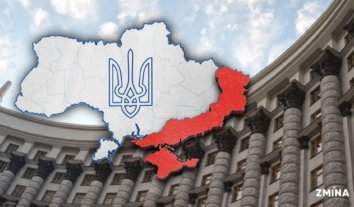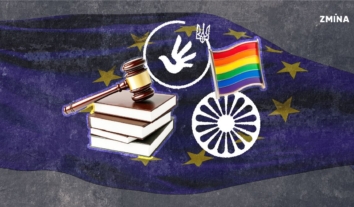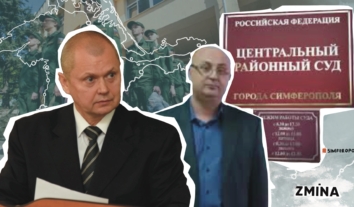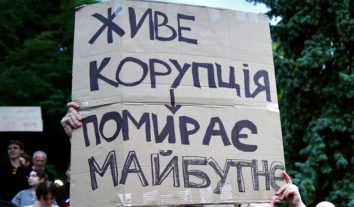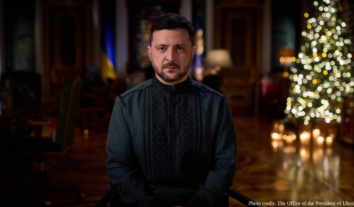Murder Because of Who You Are
In Odessa on June 2014, a group of assailants beat an Ethiopian man. He went to a store in the evening and saw a group nearby that was shouting calls for the murder of Africans, Jews and Hindus. A few minutes later, having seen the man, about 8 physically intimidating people headed towards him. The man was hit on the head with something heavy. He ran across the street, bleeding and fleeing from attack. People who were at the playground saved him from attackers and called the police and ambulance. The man was taken to the hospital where he was given treatment, including surgery. Law enforcement officers have questioned him, but the investigation went no further than that. The injured man did not file a statement to the police. He only noted that, since 2000, he has been attacked because of his ethnicity seven or eight times.
In Ukraine, such crimes are not recorded except by non-governmental organizations. Recently, the Diversity Initiative, which is coordinated by the International Organization for Migration and the United Nations High Commissioner for Refugees, has monitored cases of hate crimes in 2014.
Who Becomes a Victim?
Monitoring results indicate that Africans suffer the most from ethnicity-based attacks. Acts of vandalism are carried out mainly against Jewish and Crimean Tatar religious buildings.
Hate crimes are usually the result of prejudice or bias against certain groups of people: ethnic, religious and LGBT minorities. Experts told about cases of ethnic violence (beating a yeshiva student in Kyiv, a young Roma in Pereiaslav-Khmelnytskyi, an Ethiopian in Odessa), vandalism (neo-Nazi symbols desecrating the Grieving Mother Memorial in Poltava, the attack on the synagogue in Zaporizhia, the arson of hotel and cars belonging to Crimean Tatars in Crimean village of Rybache). Attention was also paid to cases of ethnic profiling by law enforcement, discrimination, and hate speech.
The Sad Statistics
According to monitoring data, in 2014 there were nineteen recorded cases of violence with suspected racial motivations targeted against people from Uganda, Chad, Sudan, Ethiopia, Somalia, and Cameroon, as well as Ukrainian citizens of Jewish and Roma origin. Cases have been recorded in Kyiv, Bila Tserkva, Odessa, Kharkiv, Korosten, and other cities. The number of cases increased slightly compared to 2012 and 2013 (17 and 13 cases, respectively).
Acts of vandalism, mainly against Jewish and Crimean Tatar property and a Roma settlement, were recorded in a number of localities of Crimea, as well as Novomoskovsk, Oleksandriia, Chernihiv, Chyhyryn, Kharkiv, Khmelnytsky and other cities. In total, there were 22, which is slightly more than shown in the data from 2013 (18).
Yana Salahova, an expert on combating racism and xenophobia and representative of the International Organization for Migration, notes that hate crimes can be divided into two categories: “Crimes against people (primarily, we draw attention to the violence) and crimes against property, which may belong to certain minorities: churches, synagogues, mosques, cemeteries.”
In addition, according to Salahova, attacks were carried out on cultural monuments and even the schools where members of certain ethnic minorities study.
Message of Danger
A key criterion for labeling crimes as hate crimes is that they are against the so-called “visible minorities.” The most affected are those who look different from the majority.
Salahova noted that the time of the offense plays a role. Crimes committed during the day usually have a purpose of public expression of intention and attitude. At the same time, during such crimes, there are more witnesses, which can facilitate the investigation.
Salahova spoke about what the particular danger of hate crimes is: “They are not directed against a single person. In these cases, an individual member of a minority represents the entirety of the minority, and when the offense occurs, it is a message of danger, fear for the whole community. If, for example, the attack was against a representative of the Armenian community, then this message is made against the whole Armenian community in this city or area.”
Assailants’ Strategy
Often, attacks on minorities originate from the football fans, the so-called “ultras,” especially after football matches and concerts, says Salahova.
Usually attacks are from behind and by not one, but at least three assailants. Usually such cases result in a severe beating because attackers are often well trained.
A separate problem is the so-called mixed motives for the crime. When a person is not just beaten, but also robbed, that fact is then used to disqualify the crime as a hate crime. The monitoring of social networks shows that members of neo-Nazi and other groups which have engaged in such attacks in recent years agree among themselves to take the victim’s phone or wallet to disguise their motives. In such cases, experts say, it is necessary to carefully examine whether the victim of the attack is chosen based on religious, ethnic, or other grounds.
Documentation Above All
Law enforcement agencies abroad thoroughly document and record hate crimes, says Olena Bondarenko, a representative of the No Borders Project of Social Action Center. This is used when carrying out a full investigation, although it does not replace it, as well as for statistical purposes. This data is used in preparing reports on criminal statistics.
“This is a pre-trial form: an incident that has not been proven in court, not investigated, not finished, yet is in these statistics. This is very important because sometimes these things do not reach court, or because of the inability to find the perpetrators, or due to the reluctance of victims to continue the investigation,” says Bondarenko.
Bondarenko notes how, when working with counterparts in Britain who have developed recommendations for operational activities in the investigation of such crimes, it was discovered that Ukraine lags behind by about thirty years.
“This really is long and painstaking work that has been done with the active participation of the UK police, active officers who were interested in investigating and preventing these crimes,” notes Bondarenko.
The country has developed a lightweight version of documenting hate crimes based primarily on an assessment of crime by victims and witnesses. This applies only to documentation, because investigation requires complete evidence linking the suspect to the crime.
If a fully legally-defined and convicted hate crime did not take place, but the person is sure that the actions were carried out against them on the grounds of bias, it still qualifies as a hate incident.
Investigation Nuances
According to the complaints to the Office of the Commissioner, as noted by Serhiy Ponomarev, a representative of the Secretariat of the Ukrainian Parliament Commissioner for Human Rights, Ukraine has a problem of the original incorrect classifications of such cases.
“We must talk here about both the preliminary classifications and the classifications given to the case when it is transferred to the court. Very often, when preliminarily law enforcement and investigative agencies qualified the case as a general article, Article 296 hooliganism for example, without taking into consideration motives of bigotry, it is very difficult for the victims to get the law enforcement to reclassify the case as a hate crime,” notes Ponomarev.
According to Ponomarev, this is also a question of the effectiveness of the investigation. If the pre-classification is as a general crime, like hooliganism, then investigative activities are planned accordingly. But, if the motive is intolerance, the investigation is organized differently. Different evidence is sought and different questions are asked.
Ukrainian law enforcement agencies do not always pay special attention to hate crimes. They say that investigators are too overloaded. In response, human rights advocates propose developing a methodology for dealing with such cases. Then, the process will be structured and will take less time.
Experts also note that hate crimes have a greater psychological impact on the victims because they are crimes committed because of a person’s identity, which is something you cannot change.


